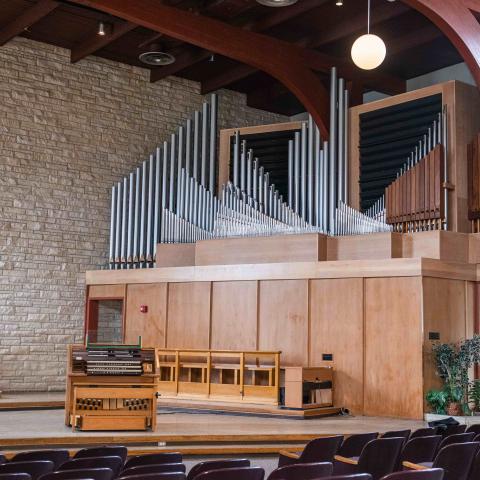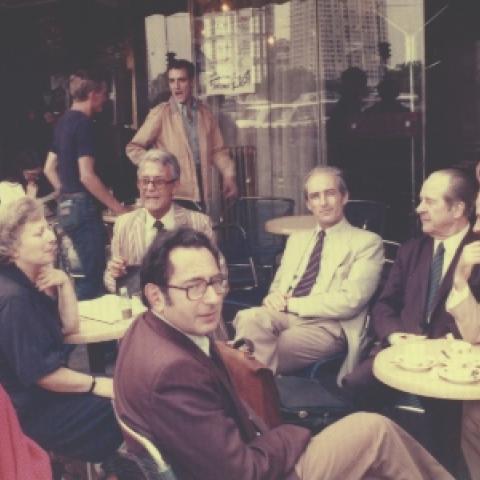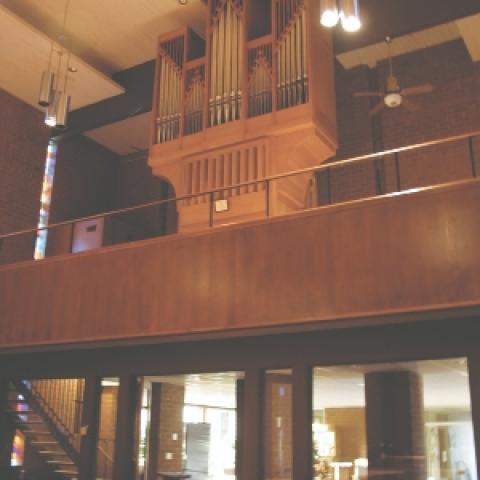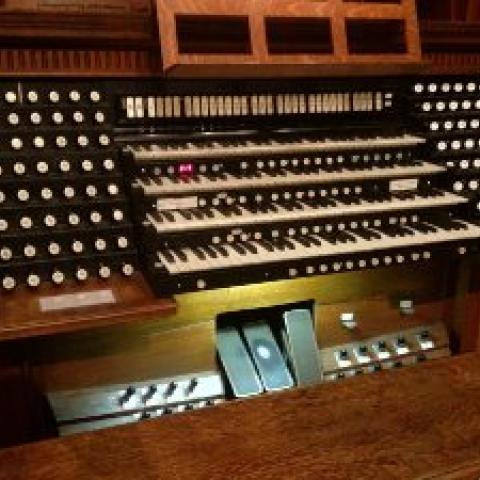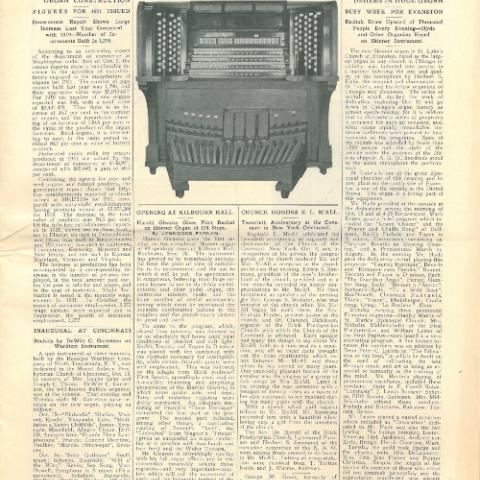Robin Côté first grew up musically at Saint Joseph’s Oratory in Montréal receiving a strong musical training from Les Petits Chanteurs du Mont-Royal. It was also at that time that he was initiated to the organ, turning pages and pulling stops for Raymond Daveluy at the Oratory’s monumental Beckerath organ. Rapidly fascinated by the process of organbuilding, he joined the Juget-Sinclair team in 2002 to receive a complete apprenticeship. He went to France to work with Michel Jurine S.A.R.L. near Lyon to improve his understanding of French Symphonic organ design, nineteenth-century organ restoration techniques, and the traditional way of making polished tin façade pipes. Robin Côté learned every essential technique to build every part of the organ from metal casting to voicing. During numerous study trips, he had free access to the insides of many significant instruments of France, Spain, Sweden, Latvia, and the United States.
For twenty years, having contributed to the making of more than forty new organ projects as general organbuilder as well as designer and voicer, Côté has shared with his team the will of building organs without compromising anything in quality and refinement. That is why he evolved as one-third partner in 2013 and now co-owner along with Stephen Sinclair, taking part of the administration of the Juget-Sinclair workshop as president since 2018.
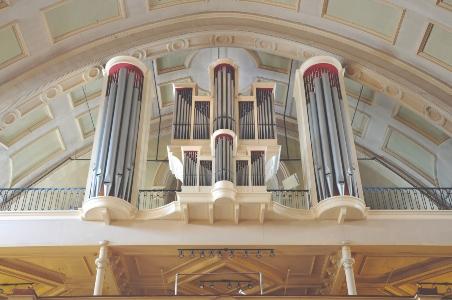
Even though this restoration project was performed years ago, I would like to dedicate this article to Gaston & Lucienne Arel, who were greatly responsible for the installation of this fantastic Beckerath organ. I had the chance to visit them at their house right before the pandemic lockdown. Gaston Arel died December 28, 2021, and this article is written in his memory.
Beckerath. I dare to argue that for any organist in Québec, as in the other Canadian provinces and the United States, this name remains significant and leaves no one indifferent. For many, Rudolf von Beckerath was the “star’’ organ builder who guided them through the rediscovery of the German Baroque organ and the possibility of articulation; while for others, it signified the end of the era dominated by super-legato. As for organbuilders, it seriously upset the order established in Québec in the 1950s; but also, it would have a profound influence on the organbuilding world, which has continued even to the present day, since Beckerath trained many apprentices who would become important organbuilders of the second half of the twentieth century. His instruments still fascinate young organists, organbuilders, and musicologists.
By the same token, carrying out the restoration of the organ of the Church of the Immaculate Conception could not be done without a certain emotional charge. Having myself bathed abundantly in the atmosphere created by the sound of the great Beckerath of Saint Joseph’s Oratory during my childhood in the oratory’s boys choir, and that of the Immaculate Conception during my training as an organist, I could only approach this project with deep respect. But before relating the different stages of the restoration project, I thought it good to go back to the origin to fully understand the context of ordering and installing this instrument. I would like to warmly thank Ms. Lucienne L’Heureux and the late Gaston Arel who agreed to share their memories, and to Russell J. Weismann for sharing some of his documentation on the Beckerath firm.
The origins of the 1961 project
Like many projects, one started with some particular circumstances. Installed in 1914, Casavant Frères Opus 565 deteriorated to the point where, in 1946, there was a need to carry out a major restoration. The console was replaced, but in the years that followed, Father Henri Lalonde, music director, reported that it
would have caused countless hassles to all the organists who have used it since the installation. Mr. [Georges-Émile] Tanguay [the organist] started to complain about it only a few weeks after the inauguration. . . . [Raymond] Daveluy waited a year before requesting a complete review of the mechanism, which revealed two significant deficiencies. . . . Mr. [Gaston] Arel, since assuming his duties, had to return the tuner Mr. Philie [from Casavant Frères] every two or three months to repair the same defect, and always with the same results.1
A decision had to be made about the future of this organ. It was therefore at the beginning of 1957 that Gaston Arel advised Father Lebel, parish priest, that there was an urgent need to act. Father Lebel replied quite simply, “You have carte blanche!”2 As the Fathers began talks with Casavant to explore the avenue for a reconstruction of the existing instrument, news of the installation of the Beckerath organ for Trinity Lutheran Church in Cleveland, Ohio, came to their attention via their young organist, Gaston Arel.3
In the spring of 1957, knowing that Beckerath was working in Cleveland, but without further information, Gaston and Lucienne Arel decided to write to him to express the interest of the Immaculate Conception Church to acquire a new organ. To their surprise, as soon as the letter was delivered to Beckerath, he phoned them immediately. They informed him that there were several potential projects in Canada and that it would be worthwhile to visit Montréal and Québec City before returning to Hamburg. Beckerath’s visit came sooner than expected because, according to Gaston and Lucienne Arel’s memories, Beckerath was shocked to find that Trinity Lutheran Church had been lined with acoustic panels between the signing of the contract and the delivery of the organ. He then threatened to return to Hamburg with his pipes if the church did not correct the situation immediately. Beckerath was successful, and it took the church three weeks to remove the panels. Meanwhile, he went to Montréal to sell organs!
Palm Sunday of 1957 (April 14), Gaston and Lucienne went to Montréal airport to pick up the organbuilder. Lucienne remembers very well having recognized him instinctively! The same day, Raymond Daveluy, Kenneth Gilbert, and Lucienne and Gaston Arel met with Rudolf von Beckerath for dinner in a French restaurant in downtown Montréal. It was then that the first draft of the Immaculate Conception organ specification was born. In the blink of an eye, Beckerath worked out the stoplist on a restaurant placemat, still kept in the Arels’ personal archives.
Following this meeting, Beckerath went to visit the church and asked Gaston to come up and play some notes to get an idea of the acoustics of the place. However, a lady sneezed and Beckerath called Gaston, who was going to the organ loft, saying that it was no longer necessary to go up because he had heard the four seconds of reverberation! In the days that followed, Beckerath visited Queen Mary Road United Church and Saint Joseph’s Oratory. It must be said that Beckerath, having lived in Paris for nine years, spoke excellent French, which made communication easy for negotiating contracts in Québec, the largest French-speaking province in Canada.
Following the meeting, Gaston Arel wrote to request an official proposal, with or without casework, based on the stoplist made on the placemat, but asking to replace the five-rank Cornet in the Brustwerk, then requested, with a two-rank Terzian—Raymond Daveluy and Kenneth Gilbert having been convinced by the effect of this stop during their visit to the Cleveland organ.4 The initial proposal was sent in early June 1957. This initial project was to be installed on the first balcony and included forty-seven stops on three manuals: the Hauptwerk based on a 16′ Prinzipal, 32′ Fagott on the Pedal, and an 8′ Prinzipal on the Rückpositiv in two sections. The following June 20, Lucienne and Gaston Arel, accompanied by R. P. Henri Lalonde, went to Cleveland to play and hear the new organ. On his return from Cleveland, Arel wrote to Beckerath asking him to return a quote for the casework, also including a pedal coupler from either the Brustwerk or Rückpositiv.5 According to the writings of Gaston Arel, Father Lalonde “has not stopped talking about it to members of his community since he was so impressed. It is thanks to this good publicity that the business seems so assured.”6
However, the securing of this project required more than convincing the authorities of the church; it was first necessary to have the approval of the Provincial Father of the Jesuits in Montréal and then the assent of the Father General in Rome. It was not until the morning of September 9, 1957, that Gaston Arel received the final news that the Father General gave his approval for the project.7 As Arel wrote, “the first race being won, there is still a second one, which is financial.”8 It was necessary to secure the project with a back-up solution. The priest in charge of the finances requested another proposal for a reduced project saving $5,000–$6,000 CDN. The suggestion described by Gaston Arel was to base the Hauptwerk on an 8′ Principal and to remove the Gemshorn Celeste from the Brustwerk, but to include an 8′ Cromorne on one of the secondary keyboards.9 Following this request, the old organ was about to be sold for $7,000 CDN, and there were no longer any questions about reducing the organ. However, the Rückpositiv in two sections was not unanimously liked; Gaston Arel suggested to Beckerath to redesign the instrument with a single Rückpositiv. Arel also asked how long the assembly of the instrument would take and how many men would need to be lodged.10 More than a month later and still unanswered by Beckerath, Arel sent another letter asking for the weight of the organ. Finally, the letter came with all the requested information: the positiv in two sections was only to make room for the choirmaster and, in any case, it was more convenient to do it in one section. The installation was to require the presence of three men for three months.11
The Fathers commissioned an engineer to find out if the first balcony could support the new organ. The idea was to ascertain if, in addition to having to demolish the second balcony, they should also strengthen the first. Thus they would only have to take out one loan for the preparatory work.12 Unfortunately, the evaluation of the first balcony revealed a lack of solidity and therefore the obligation to strengthen the structure. The cost of this work was estimated at $20,000 CDN, bringing the total cost of the project to $50,000 CDN. The Father General of the Jesuits in Rome limited the authorities of the Immaculate Conception to $30,000 CDN, and the project ultimately had to be reduced to thirty-eight stops.13
Beckerath therefore returned a new, reduced proposal. He recommended placing the organ as far forward as possible on the second balcony to optimize the presence of the instrument in the church. The cost for thirty-eight stops was 100,382 DM, which was approximately $22,800 CDN.14 The Fathers could have $7,000 CDN for their old organ, so adding to the contract the excluded costs (transport, insurance, air tickets, work visas, 15% customs, installation and painting costs of organ), the whole should not exceed $37,000 CDN. According to Father Lalonde, it was the equivalent necessary for the reconstruction of the Casavant organ of 1914.15
Without having the exact date, the contract was signed by the authorities of the Immaculate Conception between March and May 1958, because the first payment was sent on May 21, stating that the contract was already signed. The organbuilder agreed to deliver the organ within the next twenty-four months.
It should be noted that according to the terms of the contract, the organ had to be paid in three installments: a first third upon signature; a second, eight months after the signature corresponding to the start of work; and the third upon presentation of official sea transport documents, which means before the organ was even finished!16 The months passed, and the second payment was sent on January 20, 1959. Beckerath announced the end of the preparatory work for the construction of the organ to Father Lalonde, but that the construction of the parts could not begin until the completion of windchests of the organ for Saint Joseph’s Oratory, i.e., towards the end of 1959. Worse still, he announced that the union of woodworkers had wage increases applied to their members. This situation occurred twice during the execution of the contract and would have an obvious impact on the total price of the organ.17
A year later, Beckerath wrote to Father Lalonde at the end of April 1960 to inform him that he had made the final drawings for the casework of the new organ, and “that in view of the style of your church, I thought it right to choose rather classic shapes so that this case adapts well to the architecture of the nave.’’ He also announced that the Oratory organ had just been delivered, and that he would come to Montréal around September 1 for the voicing, bringing “the technical drawings to indicate the work to be done so that the new organ can be installed without difficulty.”18
In early 1960, a year before the installation, the Arels applied to the Canada Council for the Arts hoping to receive a grant for organ studies in Europe. They received their scholarship, and Gaston Arel hastened to write to Beckerath that he would leave with Lucienne on June 24 for a six-month stay. The trip was to include two months of instrument visits and a four-month internship with a master organist, possibly Helmut Walcha. Arel also mentioned that they would like to be able to stop in Hamburg to visit him and see the organ of the Immaculate Conception assembled in the workshop as well as to visit historic organs of the area.19
It was Beckerath who suggested that the Arels do their internship with Charles Letestu in Hamburg. With Letestu, they had very little to do with repertoire, but rather worked on articulation, historical fingering, and an innovative way of understanding music for that time. The Arels rented an apartment in Nienstedten in the western suburbs of Hamburg. They went into town to Letestu’s apartment for their lessons, which took place on a simple pedal clavichord! While in Hamburg, they visited Beckerath a few times at his home in Blankenese, a nearby village of Nienstedten on the banks of the Elbe.
When Beckerath had to leave for the voicing of the Oratory organ, it was the Arels who took him to the Hamburg airport. Beckerath told them at that time that he was worried about leaving for two months knowing that his wife Veronika was pregnant and that the child might be born before his return. The Arels reassured him by saying that they would be there to help his wife if needed.
According to legend, in the days after his arrival at the Oratory, he received a message that he put in his pocket to read later that evening. This message announced the birth of their son, Felix. Upon his return in November, Beckerath had the Arels over for dinner and told them about the dedication concert at the basilica on November 13, 1960. He also mentioned that he would transfer some stops to Immaculate Conception (16′ Soubasse) because they were too small for the dimensions of the basilica. At the Oratory, acoustic panels had been installed on the ceiling, greatly dampening the reverberation; but this time, Beckerath could not convince the authorities and had to react by having larger-scaled pipes delivered. Before their return to Montréal, the Arels also visited Lower Saxony in Beckerath’s company to visit historic organs. The experience was memorable because Beckerath knew which organs were worth seeing and hearing.20
The following correspondence dealt with the delivery of the instrument. At the start of 1961 the organ was ready for delivery, but the Saint Lawrence River was still frozen. Some options were evaluated, such as getting the crates through the seaport of Québec City, but the cost was much higher. The transportation costs being at the expense of the church, the choice to wait for the opening of the Saint Lawrence Seaway on March 23 was self-evident because the cost of transportation via Québec City was $5,600 CDN, and the direct Hamburg-Montreal was only $3,850 CDN.21
Finally, the organ arrived safely in May. Having been informed of the arrival of the organ by his workers, Beckerath wrote to Father Lalonde to announce that he would come soon to finish and voice the organ while asking for the final payment, including the amount for the plane tickets (nearly $1,000 CDN).22 The organ was installed and voiced during the summer of 1961. Extensive media coverage preceded the inaugural recital, played by Gaston Arel on September 24, 1961, in commemoration of the 350th anniversary of the arrival of the Jesuits in Canada.
Following the imposing concert program, the numerous critics were unanimous as to the quality of the instrument and the organist’s playing, as illustrated by this extract by J. Keable from La Presse: “[. . .] rare that the organ gives emotion. At least as far as ordinary music lovers are concerned. Last night, Gaston Arel, on the new organ of the Immaculate Conception, achieved this feat.”23 Without delay, the organ of the Immaculate Conception was played in concert and recorded numerous times. The organ concert society Ars Organi proved to be the great promoter of the instrument from the beginning.
Obviously, the project had its opponents, and many musicians expressed their opinion that it was unnecessary to have mechanical-action instruments to play early music. However, to quote Lucienne Arel, the small group formed by Daveluy, Gilbert, Arel, and Lagacé knew instinctively that these organs would have a definite impact on the generations to come. “It was too convincing, we couldn’t deny the obvious!’’24 A question comes to mind, however, knowing the pre-Vatican II context: why a Germanic and Lutheran style instrument for a French-Canadian Catholic church? Gaston Arel’s response was spontaneous and unequivocal: to be able to play the music of Johann Sebastian Bach. Musical desire transcends religious principles, and the authorities of the parish never questioned this choice.
The restoration of 2018
After more than fifty years of loyal service without major maintenance work, the organ of the Immaculate Conception had become mechanically unreliable and out of breath. The organ was still used extensively for both religious and educational purposes, as well as for the first round of the Canadian International Organ Competition. Although the idea of a restoration was launched almost ten years prior, it was not until 2018 that the funds were raised. We must salute here the dedication of the organist, Réal Gauthier, for his ability to repair the components of the pedal action, which were giving way one by one.
The organ condition before the work
We found in the manufacture of this instrument a great similarity with the great organ of Saint Joseph’s Oratory completed in 1960. Several components are identical, and most of the problems identified at the Immaculée were also found at the Oratory prior to its restoration in 2012. In general, the action was slowed down by friction, and the couplers required a complete readjustment. In the Pedal, the action had become completely misadjusted, and several parts were broken. The console had suffered the ravages of time—the hitch-down board, the expression pedal, and the pedalboard were extremely worn. The pearwood veneer on the keycheeks had lost its varnish, and dirt had settled everywhere. The case was stained with candle grease, and the only option was to repaint it, matching the original color. The primary reservoir was leaking, and the leather of the schwimmers under the windchests was starting to crumble. The pipework needed a lot of attention. The small pipes, having been tuned multiple times and at different temperatures, were collapsing at the mouth, causing many problems including instability of attack and tuning. The larger pipes were collapsing at the feet under their own weight, reducing the passage of wind. The result was a loss of sound volume and an unfocused sound and attack. The reeds, on the other hand, demanded full regulation of timbre and attack.
Restoration work
The restoration required more than 2,500 hours of work spread over four months from June to September 2018. All the mechanical elements were cleaned, repaired, and readjusted while minimizing friction. As the Hauptwerk’s pedal coupler (added by Helmuth Wolff in 1971) was from the beginning not easily adjustable, new brass wires with adjustable nuts were installed between the rollerboard and the backfalls. The grids of the windchests were leveled where the pallets are located. The pallets were also straightened and releathered. The pallet guides were then glued in place because they were known to fall from time to time causing ciphers as the pallet would become free to move laterally. All the leather in the wind system was replaced and the tremulants readjusted. The entire keydesk was restored to its original state. The pedalboard frame was reinforced, and a new adjustable bench was built. The original bench was placed next to the organ. A huge, sixty-foot scaffold had to be installed around the organ from the lower balcony to be able to reach all parts of the organ with a brush. The organ was repainted the same color as the original.
The 2,696 pipes were carefully cleaned and straightened. The scrolls were repaired and re-soldered where necessary. The lowest pipes of the Hauptwerk 8′ Prinzipal and 16′ Quintadena were suspended to prevent them from sagging further. The tin façade pipes were re-polished, and the zinc pipes thoroughly washed. Cracks in the 16′ Subbas pipes were filled with the same type of wood, and the stoppers were releathered. The reeds were all dismantled, the shallots leveled, the tuning wires adjusted, and the curves revised. Only two tongues had to be replaced. Each stop was regulated and tuned while respecting the original voicing.
In conclusion, we sincerely hope that this flagship instrument can still have a positive influence in the musical life of Montréal and Canada, and that this restoration will benefit students, teachers, organists, and the church community for a long time to come. We sincerely wish to thank all those who were involved in this project, particularly the Conseil du Patrimoine Religieux du Québec (Quebec Religious Heritage Council); the organist and music director, Réal Gauthier; the Canadian International Organ Competition (CIOC), represented then by John Grew and Thomas Leslie, for their dedication to this project.
1961 Rudolf von Beckerath
HAUPTWERK (Manual II)
16′ Quintadena
8′ Prinzipal
8′ Spitzflöte
4′ Oktav
4′ Blockflöte
2-2⁄3′ Nasat
2′ Oktav
2′ Flachflöte
Mixtur IV
16′ Fagott
8′ Trompete
RÜCKPOSITIV (Manual I)
8′ Gedeckt
8′ Quintadena
4′ Prinzipal
4′ Koppelflöte
2′ Gemshorn
1-1⁄3′ Nasat
Sesquialtera II
Scharf IV
16′ Dulzian
8′ Bärpfeife
BRUSTWERK (Manual III, enclosed)
8′ Holzgedackt
4′ Rohrflöte
2′ Prinzipal
1′ Sifflöte
Terzian II
Scharf III
8′ Dulzian
PEDAL
16′ Prinzipal
16′ Subbas
8′ Offenflöte
4′ Metalflöte
2′ Nachthorn
Rauschpfeife III
Mixtur V
16′ Posaune
8′ Trompete
4′ Schalmei
Notes
1. Pourquoi un orgue neuf, promotional media, R. P. Henri Lalonde, S.J.
2. Interview of Gaston Arel by Robin Côté, 2020.
3. Lalonde.
4. Letter from Gaston Arel to Rudolf von Beckerath, June 1, 1957.
5. Letter from Gaston Arel to Beckerath, July 8, 1957.
6. Ibid.
7. Letter from Gaston Arel to Beckerath, September 9, 1957.
8. Ibid.
9. Ibid.
10. Letter from Gaston Arel to Beckerath, September 17, 1957.
11. Letter from Beckerath to Arel, October 25, 1957.
12. Letter from Gaston Arel to Beckerath, October 22, 1957.
13. Letter from R. P. Henri Lalonde to Beckerath, February 20, 1958.
14. Letter from Beckerath to R. P. Henri Lalonde, March 13, 1958.
15. Pourquoi un orgue neuf, promotional media, R. P. Henri Lalonde, S.J.
16. Letter from Beckerath to R. P. Henri Lalonde, March 13, 1958.
17. Letter from Beckerath to R. P. Lalonde, February 12, 1959.
18. Letter from Beckerath to R. P. Lalonde, April 21, 1960.
19. Letter from Gaston Arel to Beckerath, April 25 1960.
20. Interview of Gaston Arel by Robin Côté, 2020.
21. Letter from Beckerath to R. P. Lalonde, January 6, 1961.
22. Letter from Beckerath to R. P. Lalonde, May 17, 1961.
23. La Presse, September 25, 1961.
24. Interview of Lucienne L’Heureux-Arel by Robin Côté, 2020.

